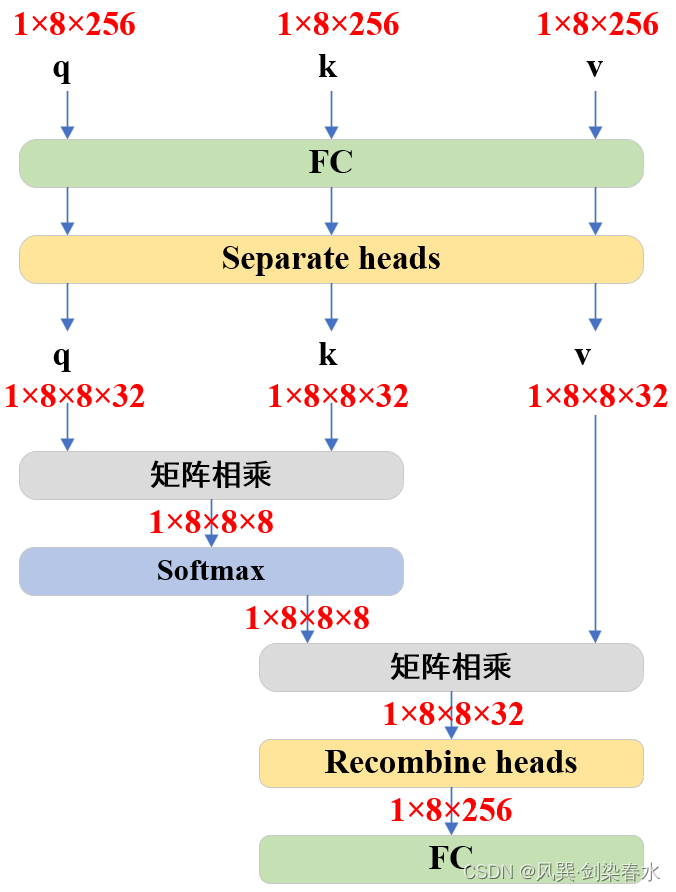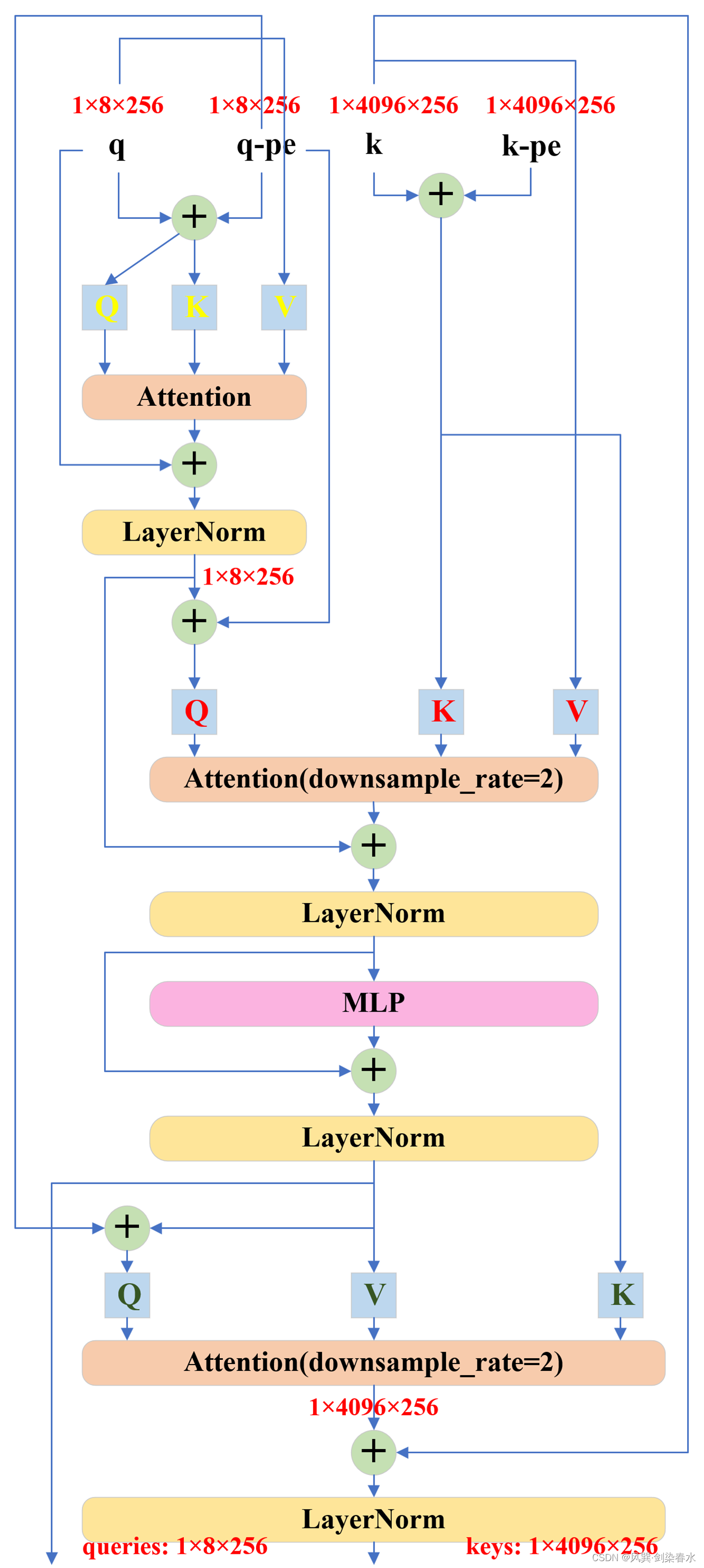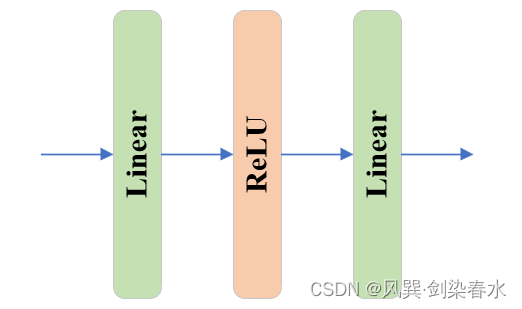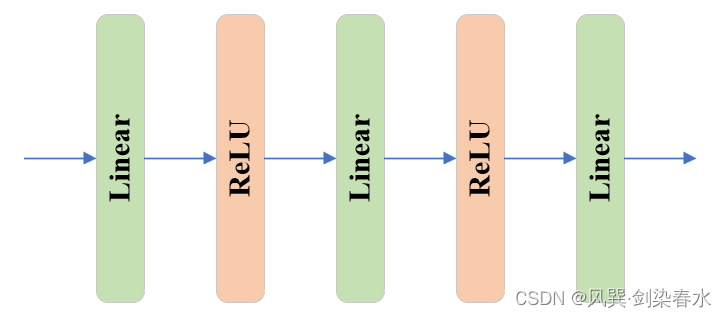-
【技术追踪】SAM(Segment Anything Model)代码解析与结构绘制之Mask Decoder
论文:Segment Anything
代码:https://github.com/facebookresearch/segment-anything系列篇:
(1)【技术追踪】SAM(Segment Anything Model)代码解析与结构绘制之Image Encoder
(2)【技术追踪】SAM(Segment Anything Model)代码解析与结构绘制之Prompt Encoder本篇示例依然采用系列篇中的狗狗图像运行代码,预测部分代码如下:
input_point = np.array([[1300, 800]]) # 输入point的坐标 input_label = np.array([1]) # label=1表示前景, label=0表示背景 # 输入box的坐标,(700,400)为左上角坐标, (1900,1100)为右下角坐标 input_box = np.array([[700, 400, 1900, 1100]]) # 调用预测函数 masks, scores, logits = predictor.predict( point_coords=input_point, point_labels=input_label, box=input_box, multimask_output=True, )- 1
- 2
- 3
- 4
- 5
- 6
- 7
- 8
- 9
- 10
- 11
1. Mask Decoder代码解析
(1)输入参数
在【segment_anything/predictor.py --> SamPredictor类 -->predict_torch函数】中调用了mask_decoder实现mask预测,如下所示:
low_res_masks, iou_predictions = self.model.mask_decoder( image_embeddings=self.features, image_pe=self.model.prompt_encoder.get_dense_pe(), sparse_prompt_embeddings=sparse_embeddings, dense_prompt_embeddings=dense_embeddings, multimask_output=multimask_output, )- 1
- 2
- 3
- 4
- 5
- 6
- 7
①参数self.features为input_image经过image_encoder嵌入后的向量,本例中大小为 [ 1 , 256 , 64 , 64 ] {[1, 256, 64, 64]} [1,256,64,64] ;
②参数sparse_embeddings为prompt point和prompt box经过prompt_encoder得到的嵌入向量,本例中其大小为 [ 1 , 3 , 256 ] {[1, 3, 256]} [1,3,256] ;
③参数dense_embeddings在本例中为无prompt mask输入时采用 nn.Embedding 的预定义嵌入向量, 其大小为 [ 1 , 256 , 64 , 64 ] {[1, 256, 64, 64]} [1,256,64,64] ;
④参数multimask_output是bool型参数,默认为True,支持多mask输出;
⑤参数self.model.prompt_encoder.get_dense_pe()调用PositionEmbeddingRandom实现位置编码,其大小为 [ 1 , 256 , 64 , 64 ] {[1, 256, 64, 64]} [1,256,64,64] ;
def get_dense_pe(self) -> torch.Tensor: return self.pe_layer(self.image_embedding_size).unsqueeze(0)- 1
- 2
(2)MaskDecoder类
位置:【segment_anything/modeling/mask_decoder.py -->MaskDecoder类】
作用: 初始化网络结构,并调用predict_masks函数实现mask和iou预测先看MaskDecoder的 _ _ i n i t _ _ {\_\_init\_\_} __init__ 初始化函数和 f o r w a r d {forward} forward 函数:
class MaskDecoder(nn.Module): def __init__( self, *, transformer_dim: int, transformer: nn.Module, num_multimask_outputs: int = 3, activation: Type[nn.Module] = nn.GELU, iou_head_depth: int = 3, iou_head_hidden_dim: int = 256, ) -> None: super().__init__() self.transformer_dim = transformer_dim # transformer的通道维度 = 256 self.transformer = transformer # 用于mask预测的transformer = TwoWayTransformer self.num_multimask_outputs = num_multimask_outputs # 消除歧义时需要的mask数量 = 3 self.iou_token = nn.Embedding(1, transformer_dim) # (1, 256) self.num_mask_tokens = num_multimask_outputs + 1 # mask数目加1 = 4 self.mask_tokens = nn.Embedding(self.num_mask_tokens, transformer_dim) # (4, 256) # 以反卷积实现4倍上采样 self.output_upscaling = nn.Sequential( nn.ConvTranspose2d(transformer_dim, transformer_dim // 4, kernel_size=2, stride=2), LayerNorm2d(transformer_dim // 4), activation(), nn.ConvTranspose2d(transformer_dim // 4, transformer_dim // 8, kernel_size=2, stride=2), activation(), ) # 4个mask对应的mlp self.output_hypernetworks_mlps = nn.ModuleList( [ MLP(transformer_dim, transformer_dim, transformer_dim // 8, 3) for i in range(self.num_mask_tokens) ] ) # iou预测对应的mlp self.iou_prediction_head = MLP( transformer_dim, iou_head_hidden_dim, self.num_mask_tokens, iou_head_depth ) def forward( self, image_embeddings: torch.Tensor, image_pe: torch.Tensor, sparse_prompt_embeddings: torch.Tensor, dense_prompt_embeddings: torch.Tensor, multimask_output: bool, ) -> Tuple[torch.Tensor, torch.Tensor]: masks, iou_pred = self.predict_masks( image_embeddings=image_embeddings, # image encoder嵌入 [1, 256, 64, 64] image_pe=image_pe, # 图像嵌入大小对应的位置编码 [1, 256, 64, 64] sparse_prompt_embeddings=sparse_prompt_embeddings, # prompt point和box嵌入 [1, 3, 256] dense_prompt_embeddings=dense_prompt_embeddings, # prompt mask嵌入[1, 256, 64, 64] ) # 输出mask.size()=[1,4,256,256], iou_pred.size()=[1,4] # Select the correct mask or masks for output if multimask_output: mask_slice = slice(1, None) # 从索引1开始取后面全部 else: mask_slice = slice(0, 1) # 从索引0开始取到1结束 masks = masks[:, mask_slice, :, :] # [1, 3, 256, 256] iou_pred = iou_pred[:, mask_slice] # [1, 3] return masks, iou_pred- 1
- 2
- 3
- 4
- 5
- 6
- 7
- 8
- 9
- 10
- 11
- 12
- 13
- 14
- 15
- 16
- 17
- 18
- 19
- 20
- 21
- 22
- 23
- 24
- 25
- 26
- 27
- 28
- 29
- 30
- 31
- 32
- 33
- 34
- 35
- 36
- 37
- 38
- 39
- 40
- 41
- 42
- 43
- 44
- 45
- 46
- 47
- 48
- 49
- 50
- 51
- 52
- 53
- 54
- 55
- 56
- 57
- 58
- 59
- 60
- 61
- 62
- 63
- 64
- 65
- 66
f o r w a r d {forward} forward 的过程中主要完成了 predict_masks 函数调用;而在 _ _ i n i t _ _ {\_\_init\_\_} __init__函数中定义了 t r a n s f o r m e r {transformer} transformer , o u t p u t _ u p s c a l i n g {output\_upscaling} output_upscaling , o u t p u t _ h y p e r n e t w o r k s _ m l p s {output\_hypernetworks\_mlps} output_hypernetworks_mlps 和 i o u _ p r e d i c t i o n _ h e a d {iou\_prediction\_head} iou_prediction_head 这四个玩意儿,接下来咱来瞅瞅他们是啥样的。
① transformer: 在【segment_anything/build_sam.py】中可以看到为transformer定义为TwoWayTransformer,prompt_embed_dim参数为256。
mask_decoder=MaskDecoder( num_multimask_outputs=3, transformer=TwoWayTransformer( depth=2, embedding_dim=prompt_embed_dim, # 256 mlp_dim=2048, num_heads=8, ), transformer_dim=prompt_embed_dim, iou_head_depth=3, iou_head_hidden_dim=256, ),- 1
- 2
- 3
- 4
- 5
- 6
- 7
- 8
- 9
- 10
- 11
- 12
TwoWayTransformer 结构如下:
class TwoWayTransformer(nn.Module): def __init__( self, depth: int, embedding_dim: int, num_heads: int, mlp_dim: int, activation: Type[nn.Module] = nn.ReLU, attention_downsample_rate: int = 2, ) -> None: super().__init__() self.depth = depth # =2 self.embedding_dim = embedding_dim # =256 self.num_heads = num_heads # =8 self.mlp_dim = mlp_dim # =2048 self.layers = nn.ModuleList() # 2个TwoWayAttentionBlock模块 for i in range(depth): self.layers.append( TwoWayAttentionBlock( embedding_dim=embedding_dim, # 256 num_heads=num_heads, # 8 mlp_dim=mlp_dim, # 2048 activation=activation, # nn.ReLU attention_downsample_rate=attention_downsample_rate, # 降采样率=2 skip_first_layer_pe=(i == 0), # 第1个TwoWayAttentionBlock为True, 第2个TwoWayAttentionBlock为False ) ) # 1个Attention模块 self.final_attn_token_to_image = Attention( embedding_dim, num_heads, downsample_rate=attention_downsample_rate ) self.norm_final_attn = nn.LayerNorm(embedding_dim) def forward( self, image_embedding: Tensor, # 图像编码:[1,256,64,64] image_pe: Tensor, # 图像位置编码:[1,256,64,64] point_embedding: Tensor, # iou_token,mask_tokens和sparse_prompt_embeddings的拼接向量:[1,8,256] ) -> Tuple[Tensor, Tensor]: # BxCxHxW -> BxHWxC == B x N_image_tokens x C bs, c, h, w = image_embedding.shape # [1, 256, 64, 64] image_embedding = image_embedding.flatten(2).permute(0, 2, 1) # [1,4096,256] image_pe = image_pe.flatten(2).permute(0, 2, 1) # [1,4096,256] # Prepare queries queries = point_embedding # 查询Q:[1,8,256] keys = image_embedding # 键值K:[1,4096,256] # Apply transformer blocks and final layernorm for layer in self.layers: queries, keys = layer( queries=queries, keys=keys, query_pe=point_embedding, key_pe=image_pe, ) # 经过两个TwoWayAttentionBlock后, queries:[1,8,256], keys:[1,4096,256] # Apply the final attention layer from the points to the image q = queries + point_embedding # [1,8,256] k = keys + image_pe # [1,4096,256] attn_out = self.final_attn_token_to_image(q=q, k=k, v=keys) # [1,8,256] queries = queries + attn_out # [1,8,256] queries = self.norm_final_attn(queries) # [1,8,256] return queries, keys- 1
- 2
- 3
- 4
- 5
- 6
- 7
- 8
- 9
- 10
- 11
- 12
- 13
- 14
- 15
- 16
- 17
- 18
- 19
- 20
- 21
- 22
- 23
- 24
- 25
- 26
- 27
- 28
- 29
- 30
- 31
- 32
- 33
- 34
- 35
- 36
- 37
- 38
- 39
- 40
- 41
- 42
- 43
- 44
- 45
- 46
- 47
- 48
- 49
- 50
- 51
- 52
- 53
- 54
- 55
- 56
- 57
- 58
- 59
- 60
- 61
- 62
- 63
- 64
- 65
- 66
- 67
- 68
- 69
- 70
Attention 结构如下:
以TwoWayAttentionBlock的第一个Attention模块为例,即:# embedding_dim = 256, num_heads=8 self.self_attn = Attention(embedding_dim, num_heads)- 1
- 2
Attention模块主要实现了Transformer中基本的attention机制,若参数downsample_rate不为1,则会先对维度进行下采样映射:
class Attention(nn.Module): def __init__( self, embedding_dim: int, # 256 num_heads: int, # 8 downsample_rate: int = 1, # 1 ) -> None: super().__init__() self.embedding_dim = embedding_dim # 256 self.internal_dim = embedding_dim // downsample_rate # 256 self.num_heads = num_heads # 8 assert self.internal_dim % num_heads == 0, "num_heads must divide embedding_dim." self.q_proj = nn.Linear(embedding_dim, self.internal_dim) # (256,256) self.k_proj = nn.Linear(embedding_dim, self.internal_dim) # (256,256) self.v_proj = nn.Linear(embedding_dim, self.internal_dim) # (256,256) self.out_proj = nn.Linear(self.internal_dim, embedding_dim) # (256,256) def _separate_heads(self, x: Tensor, num_heads: int) -> Tensor: b, n, c = x.shape x = x.reshape(b, n, num_heads, c // num_heads) return x.transpose(1, 2) # B x N_heads x N_tokens x C_per_head def _recombine_heads(self, x: Tensor) -> Tensor: b, n_heads, n_tokens, c_per_head = x.shape x = x.transpose(1, 2) return x.reshape(b, n_tokens, n_heads * c_per_head) # B x N_tokens x C def forward(self, q: Tensor, k: Tensor, v: Tensor) -> Tensor: # Input projections # 输入q:[1,8,256];k:[1,8,256];v:[1,8,256] q = self.q_proj(q) # [1,8,256] k = self.k_proj(k) # [1,8,256] v = self.v_proj(v) # [1,8,256] # Separate into heads q = self._separate_heads(q, self.num_heads) # [1,8,8,32] k = self._separate_heads(k, self.num_heads) # [1,8,8,32] v = self._separate_heads(v, self.num_heads) # [1,8,8,32] _, _, _, c_per_head = q.shape # 每个head的维度c_per_head=32 # attention机制----------------------------------------------------------------------- # 每个head实现q乘k的转置: [1,8,8,32]@[1,8,32,8]->[1,8,8,8] attn = q @ k.permute(0, 1, 3, 2) # B x N_heads x N_tokens x N_tokens attn = attn / math.sqrt(c_per_head) # q @ k(^T) / 根号d attn = torch.softmax(attn, dim=-1) # [1,8,8,8] # ----------------------------------------------------------------------------------- # Get output out = attn @ v # softmax( q @ k(^T) / 根号d ) @ v ---> [1,8,8,32] out = self._recombine_heads(out) # [1,8,256] out = self.out_proj(out) # [1,8,256] return out- 1
- 2
- 3
- 4
- 5
- 6
- 7
- 8
- 9
- 10
- 11
- 12
- 13
- 14
- 15
- 16
- 17
- 18
- 19
- 20
- 21
- 22
- 23
- 24
- 25
- 26
- 27
- 28
- 29
- 30
- 31
- 32
- 33
- 34
- 35
- 36
- 37
- 38
- 39
- 40
- 41
- 42
- 43
- 44
- 45
- 46
- 47
- 48
- 49
- 50
- 51
- 52
- 53
- 54
为避免代码看的太晕,把Attention可视化一下,没错,就是最基本的Multi-head Attention啦~

TwoWayAttentionBlock 结构如下:
以TwoWayTransformer的第一个TwoWayAttentionBlock模块为例,即:TwoWayAttentionBlock( embedding_dim=embedding_dim, # 256 num_heads=num_heads, # 8 mlp_dim=mlp_dim, # 2048 activation=activation, # nn.ReLU attention_downsample_rate=attention_downsample_rate, # 降采样率=2 skip_first_layer_pe=(i == 0), # 第1个TwoWayAttentionBlock为True )- 1
- 2
- 3
- 4
- 5
- 6
- 7
- 8
TwoWayAttentionBlock模块:
class TwoWayAttentionBlock(nn.Module): def __init__( self, embedding_dim: int, num_heads: int, mlp_dim: int = 2048, activation: Type[nn.Module] = nn.ReLU, attention_downsample_rate: int = 2, skip_first_layer_pe: bool = False, ) -> None: super().__init__() self.self_attn = Attention(embedding_dim, num_heads) # embedding_dim=256, num_heads=8 self.norm1 = nn.LayerNorm(embedding_dim) # 256 self.cross_attn_token_to_image = Attention( embedding_dim, num_heads, downsample_rate=attention_downsample_rate ) # embedding_dim=256, num_heads=8, attention_downsample_rate=2 self.norm2 = nn.LayerNorm(embedding_dim) # 256 # embedding_dim=256, mlp_dim=2048, activation=nn.ReLU self.mlp = MLPBlock(embedding_dim, mlp_dim, activation) self.norm3 = nn.LayerNorm(embedding_dim) # 256 self.norm4 = nn.LayerNorm(embedding_dim) # 256 self.cross_attn_image_to_token = Attention( embedding_dim, num_heads, downsample_rate=attention_downsample_rate ) # embedding_dim=256, num_heads=8, attention_downsample_rate=2 self.skip_first_layer_pe = skip_first_layer_pe # True def forward( self, queries: Tensor, keys: Tensor, query_pe: Tensor, key_pe: Tensor ) -> Tuple[Tensor, Tensor]: # 输入queries:[1,8,256], keys:[1,4096,256], query_pe:[1,8,256], key_pe:[1,4096,256] # Self attention block if self.skip_first_layer_pe: queries = self.self_attn(q=queries, k=queries, v=queries) # [1,8,256] else: q = queries + query_pe attn_out = self.self_attn(q=q, k=q, v=queries) queries = queries + attn_out queries = self.norm1(queries) # [1,8,256] # Cross attention block, tokens attending to image embedding q = queries + query_pe # [1,8,256] k = keys + key_pe # [1,4096,256] attn_out = self.cross_attn_token_to_image(q=q, k=k, v=keys) # [1,8,256] queries = queries + attn_out # [1,8,256] queries = self.norm2(queries) # [1,8,256] # MLP block mlp_out = self.mlp(queries) # [1,8,256] queries = queries + mlp_out # [1,8,256] queries = self.norm3(queries) # [1,8,256] # Cross attention block, image embedding attending to tokens q = queries + query_pe # [1,8,256] k = keys + key_pe # [1,4096,256] attn_out = self.cross_attn_image_to_token(q=k, k=q, v=queries) # [1,4096,256] keys = keys + attn_out # [1,4096,256] keys = self.norm4(keys) # [1,4096,256] return queries, keys- 1
- 2
- 3
- 4
- 5
- 6
- 7
- 8
- 9
- 10
- 11
- 12
- 13
- 14
- 15
- 16
- 17
- 18
- 19
- 20
- 21
- 22
- 23
- 24
- 25
- 26
- 27
- 28
- 29
- 30
- 31
- 32
- 33
- 34
- 35
- 36
- 37
- 38
- 39
- 40
- 41
- 42
- 43
- 44
- 45
- 46
- 47
- 48
- 49
- 50
- 51
- 52
- 53
- 54
- 55
- 56
- 57
- 58
- 59
- 60
- 61
- 62
- 63
- 64
可以看到TwoWayTransformer的结构以及token维度变化并不复杂,但其交错的 Q {Q} Q, K {K} K, V {V} V 确实令人眼花缭乱:

TwoWayTransformer中的MLP:
class MLPBlock(nn.Module): def __init__( self, embedding_dim: int, mlp_dim: int, act: Type[nn.Module] = nn.GELU, ) -> None: super().__init__() # embedding_dim=256, mlp_dim=2048 self.lin1 = nn.Linear(embedding_dim, mlp_dim) self.lin2 = nn.Linear(mlp_dim, embedding_dim) self.act = act() def forward(self, x: torch.Tensor) -> torch.Tensor: return self.lin2(self.act(self.lin1(x)))- 1
- 2
- 3
- 4
- 5
- 6
- 7
- 8
- 9
- 10
- 11
- 12
- 13
- 14
- 15
MLP为简单的线性、激活、线性结构:

② output_upscaling:
Sequential( (0): ConvTranspose2d(256, 64, kernel_size=(2, 2), stride=(2, 2)) (1): LayerNorm2d() (2): GELU(approximate='none') (3): ConvTranspose2d(64, 32, kernel_size=(2, 2), stride=(2, 2)) (4): GELU(approximate='none') )- 1
- 2
- 3
- 4
- 5
- 6
- 7
output_upscaling模块由两个反卷积、两个GELU激活和一个LayerNorm组成,实现了特征图的四倍上采样,在 predict_masks函数 中将 [ 1 , 256 , 64 , 64 ] {[1,256,64,64]} [1,256,64,64] 上采样至 [ 1 , 32 , 256 , 256 ] {[1,32,256,256]} [1,32,256,256] 。
src = src.transpose(1, 2).view(b, c, h, w) # reshape: [1,4096,256]-> [1,256,64,64] upscaled_embedding = self.output_upscaling(src) # [1,32,256,256]- 1
- 2
③ output_hypernetworks_mlps:
ModuleList( (0-3): 4 x MLP( (layers): ModuleList( (0-1): 2 x Linear(in_features=256, out_features=256, bias=True) (2): Linear(in_features=256, out_features=32, bias=True) ) ) )- 1
- 2
- 3
- 4
- 5
- 6
- 7
- 8
output_hypernetworks_mlps由4个MLP组成,在 predict_masks函数 中将 [ 1 , 256 ] {[1,256]} [1,256] 下采样至 [ 1 , 32 ] {[1,32]} [1,32] 。与TwoWayAttentionBlock中的MLP不同,其结构稍稍多一丢丢:
class MLP(nn.Module): def __init__( self, input_dim: int, # 256 hidden_dim: int, # 256 output_dim: int, # 32 num_layers: int, # 3 sigmoid_output: bool = False, # False ) -> None: super().__init__() self.num_layers = num_layers # 3 h = [hidden_dim] * (num_layers - 1) # [256,256] self.layers = nn.ModuleList( # [input_dim] + h: [256,256,256], h + [output_dim]:[256,256,32] nn.Linear(n, k) for n, k in zip([input_dim] + h, h + [output_dim]) ) self.sigmoid_output = sigmoid_output def forward(self, x): for i, layer in enumerate(self.layers): # i<2经线性层后relu激活 x = F.relu(layer(x)) if i < self.num_layers - 1 else layer(x) if self.sigmoid_output: x = F.sigmoid(x) return x- 1
- 2
- 3
- 4
- 5
- 6
- 7
- 8
- 9
- 10
- 11
- 12
- 13
- 14
- 15
- 16
- 17
- 18
- 19
- 20
- 21
- 22
- 23
- 24
- 25

④ iou_prediction_head:
MLP( (layers): ModuleList( (0-1): 2 x Linear(in_features=256, out_features=256, bias=True) (2): Linear(in_features=256, out_features=4, bias=True) ) )- 1
- 2
- 3
- 4
- 5
- 6
iou_prediction_head用以实现iou预测,由1个MLP完成,其结构与output_hypernetworks_mlps中的MLP一样,只是最终将 [ 1 , 256 ] {[1,256]} [1,256] 映射至 [ 1 , 4 ] {[1,4]} [1,4] ,分别代表非multimask预测时的1个mask和multimask预测时的3个mask的iou。
(3)predict_masks函数
位置:【segment_anything/modeling/mask_decoder.py --> MaskDecoder类 --> predict_masks函数】
作用: 利用上述 t r a n s f o r m e r {transformer} transformer , o u t p u t _ u p s c a l i n g {output\_upscaling} output_upscaling , o u t p u t _ h y p e r n e t w o r k s _ m l p s {output\_hypernetworks\_mlps} output_hypernetworks_mlps 和 i o u _ p r e d i c t i o n _ h e a d {iou\_prediction\_head} iou_prediction_head 四个模块,实现mask和iou预测
此时此刻,首先来重温一下,传入predict_masks函数的参数分别是什么:① image_embeddings:image encoder嵌入,大小为 [ 1 , 256 , 64 , 64 ] {[1, 256, 64, 64]} [1,256,64,64] ;
② image_pe:图像嵌入大小对应的位置编码,大小同为 [ 1 , 256 , 64 , 64 ] {[1, 256, 64, 64]} [1,256,64,64] ;
③ sparse_prompt_embeddings:prompt point和box嵌入,大小为 [ 1 , 3 , 256 ] {[1, 3, 256]} [1,3,256] ;
④ dense_prompt_embeddings:prompt mask嵌入,大小为 [ 1 , 256 , 64 , 64 ] {[1, 256, 64, 64]} [1,256,64,64] ;def predict_masks( self, image_embeddings: torch.Tensor, # [1, 256, 64, 64] image_pe: torch.Tensor, # [1, 256, 64, 64] sparse_prompt_embeddings: torch.Tensor, # [1, 3, 256] dense_prompt_embeddings: torch.Tensor, # [1, 256, 64, 64] ) -> Tuple[torch.Tensor, torch.Tensor]: """Predicts masks. See 'forward' for more details.""" # Concatenate output tokens # 拼接iou的token和mask的token: [1,256]+[4,256]->[5,256] output_tokens = torch.cat([self.iou_token.weight, self.mask_tokens.weight], dim=0) output_tokens = output_tokens.unsqueeze(0).expand(sparse_prompt_embeddings.size(0), -1, -1) # [1,5,256] # iou的token和mask的token + prompt point和box嵌入 tokens = torch.cat((output_tokens, sparse_prompt_embeddings), dim=1) # [1,8,256] # Expand per-image data in batch direction to be per-mask src = torch.repeat_interleave(image_embeddings, tokens.shape[0], dim=0) # 按batch重复: [1,256,64,64] src = src + dense_prompt_embeddings # [1,256,64,64] pos_src = torch.repeat_interleave(image_pe, tokens.shape[0], dim=0) # 按batch重复: [1,256,64,64] b, c, h, w = src.shape # 1,256,64,64 # Run the transformer # src是image encoder嵌入和prompt mask嵌入 # pos_src是图像嵌入大小对应的位置编码 # tokens是iou的token和mask的token + prompt point和box嵌入 hs, src = self.transformer(src, pos_src, tokens) # hs:[1,8,256], src:[1,4096,256] iou_token_out = hs[:, 0, :] # 第1个为iou的token输出[1,256] mask_tokens_out = hs[:, 1: (1 + self.num_mask_tokens), :] # 随后4个为mask的token输出[4,256] # Upscale mask embeddings and predict masks using the mask tokens src = src.transpose(1, 2).view(b, c, h, w) # reshape: [1,4096,256]-> [1,256,64,64] upscaled_embedding = self.output_upscaling(src) # [1,32,256,256] hyper_in_list: List[torch.Tensor] = [] for i in range(self.num_mask_tokens): hyper_in_list.append(self.output_hypernetworks_mlps[i](mask_tokens_out[:, i, :])) hyper_in = torch.stack(hyper_in_list, dim=1) # [1,4,32] b, c, h, w = upscaled_embedding.shape # 1,32,256,256 masks = (hyper_in @ upscaled_embedding.view(b, c, h * w)).view(b, -1, h, w) # [1,4,256,256] # Generate mask quality predictions iou_pred = self.iou_prediction_head(iou_token_out) # [1,4] return masks, iou_pred- 1
- 2
- 3
- 4
- 5
- 6
- 7
- 8
- 9
- 10
- 11
- 12
- 13
- 14
- 15
- 16
- 17
- 18
- 19
- 20
- 21
- 22
- 23
- 24
- 25
- 26
- 27
- 28
- 29
- 30
- 31
- 32
- 33
- 34
- 35
- 36
- 37
- 38
- 39
- 40
- 41
- 42
- 43
- 44
由此可见,经TwoWayTransformer获得了iou_token_out和mask_tokens_out,iou_token_out由iou_prediction_head(1个MLP)实现iou预测,4个mask_tokens_out分别经过1个MLP所获得的映射拼接后,与经过output_upscaling上采样后的图像嵌入(包含image encoder嵌入和prompt mask嵌入)进行矩阵相乘,得到mask预测。
2. Mask Decoder结构绘制
(1)结构打印
MaskDecoder( (transformer): TwoWayTransformer( (layers): ModuleList( (0-1): 2 x TwoWayAttentionBlock( (self_attn): Attention( (q_proj): Linear(in_features=256, out_features=256, bias=True) (k_proj): Linear(in_features=256, out_features=256, bias=True) (v_proj): Linear(in_features=256, out_features=256, bias=True) (out_proj): Linear(in_features=256, out_features=256, bias=True) ) (norm1): LayerNorm((256,), eps=1e-05, elementwise_affine=True) (cross_attn_token_to_image): Attention( (q_proj): Linear(in_features=256, out_features=128, bias=True) (k_proj): Linear(in_features=256, out_features=128, bias=True) (v_proj): Linear(in_features=256, out_features=128, bias=True) (out_proj): Linear(in_features=128, out_features=256, bias=True) ) (norm2): LayerNorm((256,), eps=1e-05, elementwise_affine=True) (mlp): MLPBlock( (lin1): Linear(in_features=256, out_features=2048, bias=True) (lin2): Linear(in_features=2048, out_features=256, bias=True) (act): ReLU() ) (norm3): LayerNorm((256,), eps=1e-05, elementwise_affine=True) (norm4): LayerNorm((256,), eps=1e-05, elementwise_affine=True) (cross_attn_image_to_token): Attention( (q_proj): Linear(in_features=256, out_features=128, bias=True) (k_proj): Linear(in_features=256, out_features=128, bias=True) (v_proj): Linear(in_features=256, out_features=128, bias=True) (out_proj): Linear(in_features=128, out_features=256, bias=True) ) ) ) (final_attn_token_to_image): Attention( (q_proj): Linear(in_features=256, out_features=128, bias=True) (k_proj): Linear(in_features=256, out_features=128, bias=True) (v_proj): Linear(in_features=256, out_features=128, bias=True) (out_proj): Linear(in_features=128, out_features=256, bias=True) ) (norm_final_attn): LayerNorm((256,), eps=1e-05, elementwise_affine=True) ) (iou_token): Embedding(1, 256) (mask_tokens): Embedding(4, 256) (output_upscaling): Sequential( (0): ConvTranspose2d(256, 64, kernel_size=(2, 2), stride=(2, 2)) (1): LayerNorm2d() (2): GELU(approximate='none') (3): ConvTranspose2d(64, 32, kernel_size=(2, 2), stride=(2, 2)) (4): GELU(approximate='none') ) (output_hypernetworks_mlps): ModuleList( (0-3): 4 x MLP( (layers): ModuleList( (0-1): 2 x Linear(in_features=256, out_features=256, bias=True) (2): Linear(in_features=256, out_features=32, bias=True) ) ) ) (iou_prediction_head): MLP( (layers): ModuleList( (0-1): 2 x Linear(in_features=256, out_features=256, bias=True) (2): Linear(in_features=256, out_features=4, bias=True) ) ) )- 1
- 2
- 3
- 4
- 5
- 6
- 7
- 8
- 9
- 10
- 11
- 12
- 13
- 14
- 15
- 16
- 17
- 18
- 19
- 20
- 21
- 22
- 23
- 24
- 25
- 26
- 27
- 28
- 29
- 30
- 31
- 32
- 33
- 34
- 35
- 36
- 37
- 38
- 39
- 40
- 41
- 42
- 43
- 44
- 45
- 46
- 47
- 48
- 49
- 50
- 51
- 52
- 53
- 54
- 55
- 56
- 57
- 58
- 59
- 60
- 61
- 62
- 63
- 64
- 65
(2)结构绘制
整体结构就是这样的啦,完结,撒花~

-
相关阅读:
Base64
AMEYA360分析:炬玄智能高精准度、低相噪TCXO时钟补偿芯片
深入理解 MyBatis 的核心配置
Python爬虫实战(七):某讯较真辟谣小程序爬虫
OSPF 动态路由协议(思科、华为)
《小狗钱钱》阅读笔记(三)
springboot+二手车交易系统 毕业设计-附源码131456
python模块的介绍和导入
virtualBox安装配置使用
客户中心架构设计
- 原文地址:https://blog.csdn.net/qq_43426908/article/details/133877154